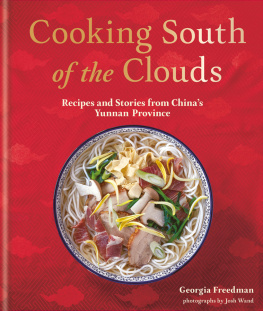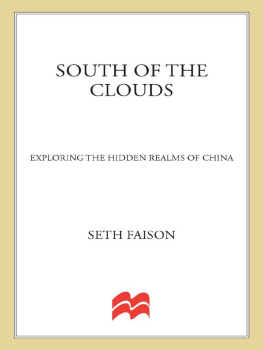Georgia Freedman - Cooking South of the Clouds
Here you can read online Georgia Freedman - Cooking South of the Clouds full text of the book (entire story) in english for free. Download pdf and epub, get meaning, cover and reviews about this ebook. year: 2018, publisher: Octopus, genre: Home and family. Description of the work, (preface) as well as reviews are available. Best literature library LitArk.com created for fans of good reading and offers a wide selection of genres:
Romance novel
Science fiction
Adventure
Detective
Science
History
Home and family
Prose
Art
Politics
Computer
Non-fiction
Religion
Business
Children
Humor
Choose a favorite category and find really read worthwhile books. Enjoy immersion in the world of imagination, feel the emotions of the characters or learn something new for yourself, make an fascinating discovery.
- Book:Cooking South of the Clouds
- Author:
- Publisher:Octopus
- Genre:
- Year:2018
- Rating:5 / 5
- Favourites:Add to favourites
- Your mark:
- 100
- 1
- 2
- 3
- 4
- 5
Cooking South of the Clouds: summary, description and annotation
We offer to read an annotation, description, summary or preface (depends on what the author of the book "Cooking South of the Clouds" wrote himself). If you haven't found the necessary information about the book — write in the comments, we will try to find it.
Cooking South of the Clouds — read online for free the complete book (whole text) full work
Below is the text of the book, divided by pages. System saving the place of the last page read, allows you to conveniently read the book "Cooking South of the Clouds" online for free, without having to search again every time where you left off. Put a bookmark, and you can go to the page where you finished reading at any time.
Font size:
Interval:
Bookmark:



Select one of the chapters from the and you will be taken to a list of all the recipes covered in that chapter.
Alternatively, jump to the to browse recipes by ingredient.
Look out for linked text (which is in blue) throughout the ebook that you can select to help you navigate between related recipes.
You can double tap images to increase their size. To return to the original view, just tap the cross in the top left-hand corner of the screen.
MY LOVE AFFAIR WITH YUNNAN began with a bowl of noodle soup. It was a sunny day in the summer of 2000, and I was sitting in a restaurant in Kunming, the capital of Yunnan Province. A young waitress approached. Guoqiao mixian? she asked, knowing already what I had come for. I nodded, and in just a couple of minutes she returned carrying a huge bowl of steaming broth and a tray covered with tiny white saucers, each filled with one of the soups ingredients.
The waitress set the bowl on the table, handed me a pair of chopsticks, mimed stirring, and began adding the soups ingredients. First came a little saucer of quail eggs that slid into the bowl and quickly turned into silky strands. Next came rich, salty Yunnan ham, sliced so thin that the pieces were translucent. Then an assortment of vegetables and herbs, from cabbage to fresh porcini mushrooms to delicate spring onions. And lastly, a tangle of thick, freshly made rice noodles, which became soft and toothsome in the broth. When everything had cooked through, I took a sip. The flavour was rich and complex, with hints of earthiness from the ham and mushrooms and bright vegetal flavours from the herbs.
This soup, called Crossing the Bridge Rice Noodles (guoqiao mixian), was the whole reason I was in Kunming, a tiny city on the southwestern edge of China. I was a college student and had been studying Mandarin in Beijing when I came across a story about this soups history in one of my textbooks. According to legend, there was once a scholar who was studying for his exams on an island in the centre of a lake near the town of Mengzi, in southern Yunnan. His wife (whose name is lost to antiquity) brought the scholar lunch every day, but it was always cold by the time she arrived. One day, when the wife had not had time to prepare a full meal, she grabbed a saucepan of rich broth and all the raw ingredients that she could find in her kitchen and made her way to the island. When she arrived, she realised that the fat in the broth had risen to the top of the pot, keeping the soup underneath piping hot. She quickly added all the other ingredients to the bowl, where the heat of the soup cooked them perfectly. The scholar loved the soup, and just like that, a delicious classic was born.

Ingredients for Crossing the Bridge Rice Noodles at a restaurant in southern Yunnan

Clockwise from top left: an afternoon snack in a Mosuo family home; Shibao Shan (Stone Treasure Mountain); a building in the Zhu Family Garden in Jianshui
For some reason this story stuck with me. Perhaps it was the idea of the eggs and the noodles and the ham, which sounded like an ideal combination of flavours. Or perhaps it was the descriptions of Yunnan a province of forests filled with native rhododendrons and azaleas, towns full of mud brick houses with sloping tiled roofs, jungles teeming with monkeys and elephants, and a population that includes dozens of different Chinese minority groups, each with its own unique traditions and customs. Yunnan had captured my imagination, so when I had a break from classes, I went in search of that soup.
After the heat and frenzy of Beijing in July, Kunming seemed like heaven. The weather was beautiful and spring-like, with warm days and cool, clear nights. The city itself was beautiful, full of peaceful temples and old wooden buildings. Even the pace of daily life seemed calmer and quieter than in other parts of China; one afternoon I sat out a rain shower in the citys central park reading and drinking tea without seeing another soul walk by. It was idyllic.
As soon as I got my bearings, I started looking for somewhere to try Crossing the Bridge Rice Noodles. At the citys famous bird and flower market a narrow street shaded by sycamore trees and lined with stalls selling parakeets, lovebirds, baby rabbits, tiny turtles and even flying squirrels an elderly man in a Mao suit and a cloth cap pointed me to a building on the corner. In a couple of minutes, I found myself in an airy, sunny room overlooking the market, sipping that wondrous bowl of soup.
I left Yunnan very reluctantly that summer, and for years I dreamed about going back. I visited China for work and vacation a few times in the following years, exploring Beijing, Shanghai, Hong Kong and the scenic towns of Suzhou and Yangshuo, but Kunming, the city of perpetual spring, was always on my mind, and every winter I found myself craving that magical soup.
Finally, in the spring of 2011, my husband, Josh, and I quit our jobs, packed up our lives (and our two cats), and moved everything to Yunnan with a vague idea about exploring the provinces many food traditions. Kunming had changed dramatically since my first visit. Like the rest of China, it was in the midst of a massive economic boom. The population had doubled, new suburbs full of high-rise apartment buildings were springing up, and the roads were choked with cars. Much of the citys centre, however, retained its unique character, with its winding tree-lined streets, small family-run shops and flower-filled parks. Josh and I found a lovely apartment on the sixth floor of a building on a narrow street just two blocks from a park (the same one where I had sipped tea during that rainstorm), and from there we set out to explore everything Yunnan had to offer.

Yunnan is the other China, the place where the culture of the Han majority gives way to the traditions and histories of the countrys minorities. The province is the most diverse part of China culturally, biologically and meteorologically. Stretching from the southern edge of the Tibetan plateau down to Laos and Vietnam, Yunnan has glacier-topped mountains, vast alpine meadows and enormous swaths of tropical rain forest in an area so small you could drive from one extreme to the other in just two days. Even its name made up of the characters for clouds and south evoke the provinces unique profile as a warm, sunny land tucked just below one of the highest and coldest places on earth.
The great rivers of Asia the Lancang (also called the Mekong), the Jinsha (or Yangtze), the Pearl River, the Red River and the Salween (or Nu) all flow through Yunnan, carving deep valleys and trenches into the mountainous landscape. The provinces many mountain ranges have given gardeners everything from ornamental bamboos to rhododendrons, and hundreds of varieties of mushrooms grow here, from truffles to matsutakes. Biologists from around the world travel to Yunnan to study the regions thousands of still-mysterious plant, animal and insect species.
Font size:
Interval:
Bookmark:
Similar books «Cooking South of the Clouds»
Look at similar books to Cooking South of the Clouds. We have selected literature similar in name and meaning in the hope of providing readers with more options to find new, interesting, not yet read works.
Discussion, reviews of the book Cooking South of the Clouds and just readers' own opinions. Leave your comments, write what you think about the work, its meaning or the main characters. Specify what exactly you liked and what you didn't like, and why you think so.







